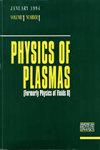Multipactor analysis of 431 MHz L-shaped inductive output tube cavity
IF 2.2
3区 物理与天体物理
Q3 PHYSICS, FLUIDS & PLASMAS
引用次数: 0
Abstract
Gridless inductive output tubes (IOTs) offer compact size and high-power amplification at sub-GHz frequencies. Minimizing cavity dimensions in the interest of compactness leads to smaller gaps, which may cause multipactor discharge under high-power operating conditions. The uncontrolled electron growth resulting from multipactor breakdown can lead to undesired effects including surface damage and system failure. This paper performs a parallel-plate multipactor analysis for a high-Q, L-shaped, aluminum, 431 MHz cavity designed for a gridless IOT to be operated in the MW-power regime. The cavity gap is 27 mm, and diameter is 339 mm. Multipactor susceptibility regions are calculated for non-zero emission energy, half-cycle, and non-half-cycle multipactor using a semi-analytic approach and a standard aluminum secondary electron yield (SEY) curve. The analytical results are validated with particle-in-cell simulation in CST Studio. Simulation results show a voltage range of 6.4–19 kV, compared to the analytically calculated values of 8.2 and 18.3 kV for the lower and upper bounds, respectively. Fluorocarbon coating as a means to reduce secondary electron emission is simulated, which shows 46% reduction in peak particle population with an 11.2 nm PTFE coating, with further reduction as coating thickness increases. The results show that the L-shaped cavity is a suitable choice for this IOT design as it does not exhibit single-surface multipactor and will not develop two-surface multipactor at full-power operation.431 MHz L 型电感式输出管腔的多因子分析
无栅电感输出管(IOT)体积小巧,可在 GHz 以下频率实现大功率放大。为追求紧凑而尽量缩小腔体尺寸会导致间隙变小,这可能会在大功率工作条件下引起多反应器放电。多反应器击穿导致的电子不受控增长可能会带来不良后果,包括表面损坏和系统故障。本文对一个高 Q 值、L 形、铝质、431 MHz 的腔体进行了平行板多因子分析,该腔体是为在兆瓦级功率下运行的无栅 IOT 而设计的。空腔间隙为 27 毫米,直径为 339 毫米。利用半解析方法和标准铝二次电子产率(SEY)曲线,计算了非零发射能量、半周期和非半周期多反应器的多反应器感应区域。分析结果与 CST Studio 中的粒子-电池仿真进行了验证。模拟结果显示电压范围为 6.4-19 kV,而分析计算值的下限和上限分别为 8.2 kV 和 18.3 kV。模拟将碳氟化合物涂层作为减少二次电子发射的手段,结果显示,11.2 nm 聚四氟乙烯涂层的峰值粒子群减少了 46%,随着涂层厚度的增加,粒子群进一步减少。结果表明,L 形空腔是这种物联网设计的合适选择,因为它不会出现单面多粒子现象,而且在全功率运行时也不会出现双面多粒子现象。
本文章由计算机程序翻译,如有差异,请以英文原文为准。
求助全文
约1分钟内获得全文
求助全文
来源期刊

Physics of Plasmas
物理-物理:流体与等离子体
CiteScore
4.10
自引率
22.70%
发文量
653
审稿时长
2.5 months
期刊介绍:
Physics of Plasmas (PoP), published by AIP Publishing in cooperation with the APS Division of Plasma Physics, is committed to the publication of original research in all areas of experimental and theoretical plasma physics. PoP publishes comprehensive and in-depth review manuscripts covering important areas of study and Special Topics highlighting new and cutting-edge developments in plasma physics. Every year a special issue publishes the invited and review papers from the most recent meeting of the APS Division of Plasma Physics. PoP covers a broad range of important research in this dynamic field, including:
-Basic plasma phenomena, waves, instabilities
-Nonlinear phenomena, turbulence, transport
-Magnetically confined plasmas, heating, confinement
-Inertially confined plasmas, high-energy density plasma science, warm dense matter
-Ionospheric, solar-system, and astrophysical plasmas
-Lasers, particle beams, accelerators, radiation generation
-Radiation emission, absorption, and transport
-Low-temperature plasmas, plasma applications, plasma sources, sheaths
-Dusty plasmas
 求助内容:
求助内容: 应助结果提醒方式:
应助结果提醒方式:


